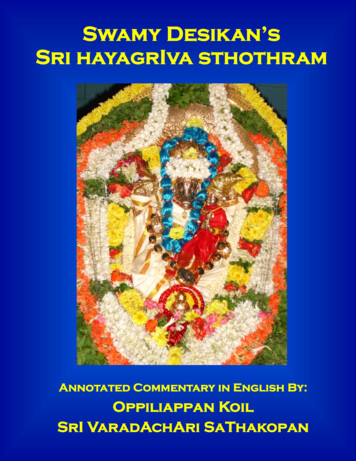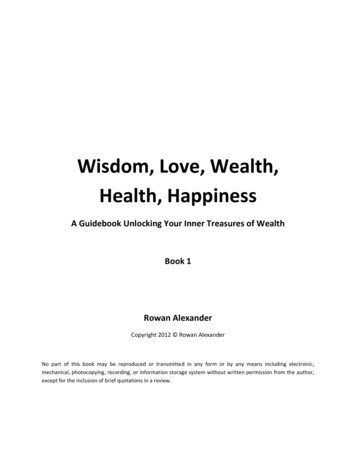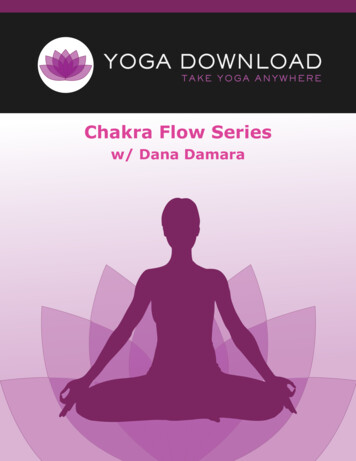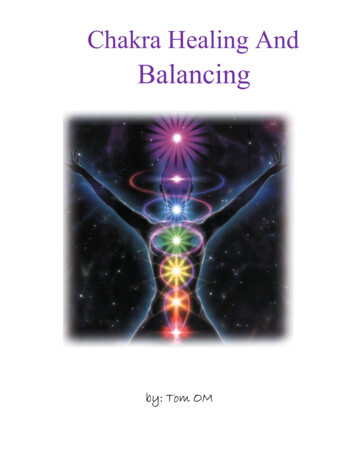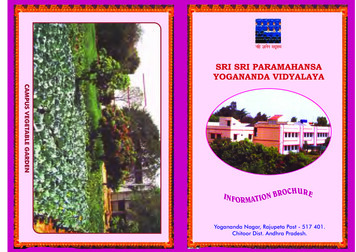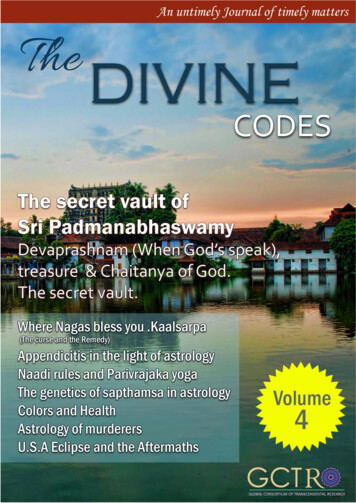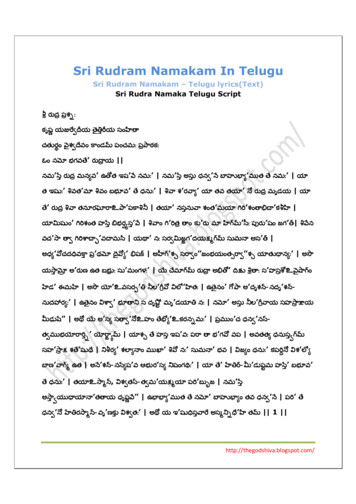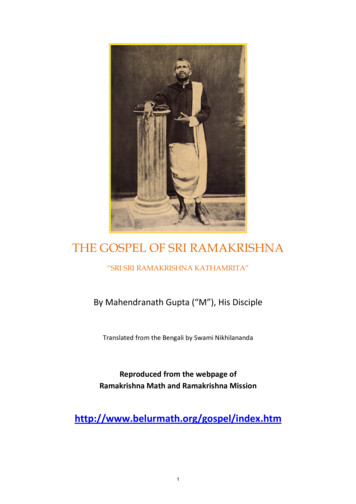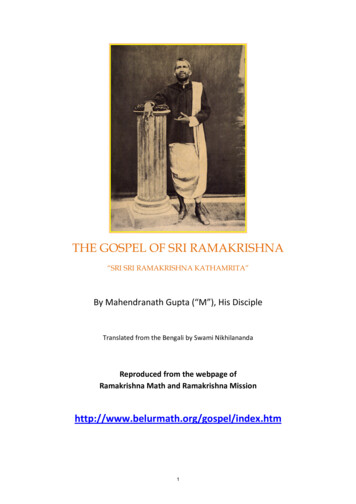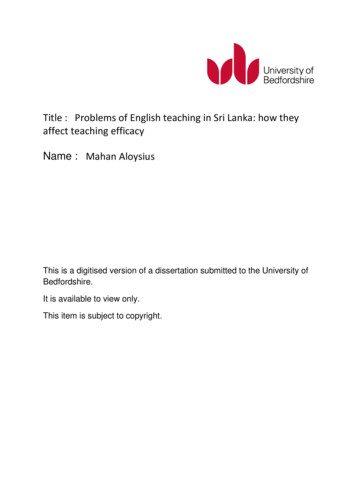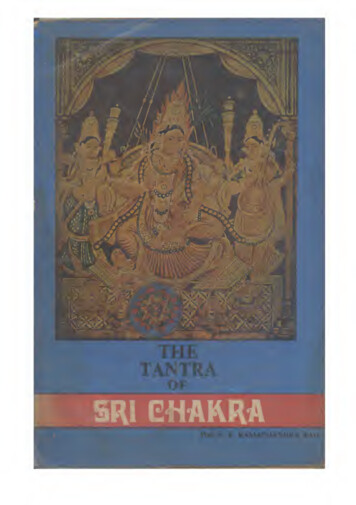
Transcription
MERUOFSRI-CHAKRAABOUT THE BOOKThere is hardly a Hindu devotee who has not heard of Sri-Chakra,seen one or held it in reverence. Despite this popularity, however, few areacquainted with details of this diagram or its symbolism and fewer still withthe philosophical foundations of its worship.Here is a book, the first of its kind, written by a well-known scholarand author, drawing the material from original and mostly unpublished sources.The Bhavanopanishad, which is the tantrik text for Sri-Chakra, hasbeen translated and annotated here, along with citations from other tantriksources. The cult has been explained here in detail.It is at once philosophical, psychological and esoteric in approach. It ismeant for the layman and the scholar alike.SRI-CHAKRA — Rs.35 - 00
THE TANTRA OFSRI-CHAKRA(BHAVANOPANISHAT)byVidydlankdraProf. S. K. RAMACHANDRA RAOp,ft'easA cS RoOO* 1Roa1'11
THE TANTRA OF SrI-CHAKRA, (Bhavanopanishat)Wntten by Vidyalankara Prof. S. K. Raraachandra Rao, andPublished by Sharada Prakashana, BangaIorc-53 (First Edition)1983Sole DistributorsM/s.M/s.T. N. Krishniah Setty & SonBooksellers & Publishers235, Chickpet - Bangalore-560 053(South India)Janardhana Publishers,Renuka Building, A. M. Lane,Bangalore-560 053 (South India)Printed byW. Q, Judge Press, (Division of Grafiprint Private Ltd.,)97, Residency Road, Bangalore-560 025 INDIA
CONTENTSTHE TANTRA OF -veda2Upanishadic Framework.3Bhavanopanishat4The Meaning of BhavanaTHE TEXT. —*.5. .—.28
ITHE MEANING OF CHAKRAThe Sanskrit expression ‘chakra’ usually means a ‘wheel’.The etymology of the word would suggest ‘that by which any thing is done’ (kriyate anena). The wheel of the cart, thewheel of the potter, the wheel-like weapon that is flung againstthe enemy are all called ‘chakras’. In its extended meaning,
chakra also signifies a kingdom, and because the wheels ofthe King’s chariot can roll on there without hindrance. TheKing of the land is thus described as a ‘chakra-vartin’. Theword also signifies an arrangement of the army (chakravyuha), in order to fortify its position and secure victory.Sanskrit poets are found to employ characteristically circularpatterns of letters of words (chakra-bandha), to convey themeaning more forcefully (if also more tortuously) than usual.-Whatever the sense in which the word is employed, it in variably means a power-field, an arrangement of parts soas to accomplish the desired end. The circular form which thechakra usually brings to mind, denotes both comprehensionand facility. It comprehends all the parts, units and detailsin a compact and effective manner, so that the whole formis unitary and functional.But the form need not necessarily be circular. The idea ofcomprehension may be metaphorical, as in expressions likertu-chakra ('the round of the seasons’), rdsi-chakra ('the pat tern of the zodiac’), nakshatra-chakra ('the collection ofstars’) and nddi-chakra (‘the arrangement of arteries’).The psyehophysiological constructs of normal human energyin terms of the six 'chakras’ (muladhdra at the base, svadhishthana at the root of the penis, manipura near the navel,andhata in the heart, visuddha behind the throat, djna bet ween the eye-brows) answer to the same description. Each ofthese chakras is a conceptual categorization of a pattern ofenergies, proper to that level of organization. The chakras donot suggest anatomical parts, nor even physiological functions.They are entirely abstractions even as the sahasrara (‘thethousand-petalled lotus’, which is in actuality outside the psy chophysical framework, and hence called nirdlamba-purt)imagined to be on top of the head, the mcmas-chakra (‘themind centre’, responsible for the experiences of dream, halluci nation etc.), and the soma-ohakra (the moon-centre’, respon-
Illsible for compassion, dispassion, generosity, patience etc.) are.They are individual vorteces of energy dynamics.The imagery of chakra as a potent pattern of forces in volving cohesion, regularity and functional unity is an oldone in India. Its visual representation is to be found even inthe remains of the Indus valley civilization, and its verbalexpression is to be found even in the hymns included inRgveda. Since those early days, it is a recurrent imagery em ployed in diverse contexts: as samsdra-chakra (‘the transmigratory round of phenomenal occurrences’), kdla-chakra (‘thegenerative cycle of time’), dharma-chakra (the wheel ofthe doctrine’), yogini-chakra (‘the representation of re current female divinities’), mantra-chakm (‘the cycle ofsacred formulae’) and so on. It is interesting to note that inextreme tantrik practices which are also antinomian incharacter, the mystic sessions of spiritual orgies were calledchakras (viz., the aggregation of participants who are unitedunder a common cultic discipline), and the deliberation in suchsessions was called chakra-puja, a term of dubious reputation.The idea of an effective aggregation of abstract deities, con cretely represented by initiated human participants, in a my stically potent session was basic to this tantrik context. Theconcept of bhairavi-chakra where drink and debauchery aresubliminated to their spiritual counterparts is well-knowTn inoccult literature. The same idea is relevant in the concept ofrasa-mandala, a particular pattern of the male and femaledevotees of Krshna, identifying themselves with Krshna andthe cowherd damsels (gopis), engaged in dance-rituals involv ing amorous details.Incidentally, the expression mandala is generally synonymouswith chakra. This word also means a wheel, something circular,a unitary aggregation of details, a kingdom, an army. Wehave words like dharani-mandala or bhu-mandala ("‘the earthcircle'), surya-mandala (‘the solar orb’), chandm-mandala (‘thelunar orb’), nara-mandala (‘the aggregation of arteries’),nabhi-mandala (‘the pattern of energies at the navel center’),
ivand tdrd mandala (‘the group of stars’). This word acquiredan especial cultic significance in the tantras belonging to. theMahayana Buddhist persuation and to the Natha-siddha ideology. ‘Mandala-offering’ and ‘mandala-visualization’ are impor tant details in the religious practices of Tibet, Mongolia andJapan. And there are treatises dealing with il/awdala-worshipand explaining its symbolism written by Natha-siddhas, Bud dhist tantrik masters and Tibetan yogis.Mandate in this context is defined as ‘that which gathersthe essential details’ (mandam lati). A popular tantrik text,Tantra-raja-tantra describes the nature and uses of mandate inworship and in meditation. Like, chakra, ‘mandate, denotes anact of concentration of all the significant details of the world,or of a doctrine, of ones own constitution or of his own mind.It. is also the place where such concentration is facilitated. Asan act of concentration, it gathers up the inner energies, andas a place for concentration, it brings together the outerenergies. It is an expedient or device that has been tried out,confirmed and standardized.It is also called a yrnitra, which is usually described as aconcrete, mostly visual, representation of the act of concen tration of the devotee’s own thoughts as well as the place ofconcentration of the forces in the outside world. It is moreoften looked upon as a gadget, a contraption, a mechanicaldevice. The three words, chakra, mandate and yantra, are infact* synonymous. But in popular imagination, each connotes acharacteristic feature that distinguishes it from others. Forinstance, chakra suggests a circular form, while the mandatemay be a figure of any shape (usually a square). While bothchakra and mandaXa are usually linear representations (some times brilliantly coloured, especially mandate), yantra is athree-dimensional model. It must be noted that there is also athree-dimensional model of Sn-chakra (called mem), and thatthere are physical models of mandates in various materials inTibet and Japan (especially for offering). And not infrequentlySrl-chakra is also called Sn-yantra,
VWhether it is called a chakra, mandala or a y.antra, theinstrument is a sphere of influence, a consecrated ground, anarena for the play of thoughts, feelings and forces both insidethe devotee and outside him. It is an instrument that is em ployed to activate energies, stimulate thoughts, harmonize feel ings, and co-ordinate inner and outer forces. It is rightly des cribed as a psychocosmogram.As an instrument mediating between the aspects of energyinside the individual and the dimensions of energy outsidehim, it is structured functionally into three levels of ‘space’ asa medium of movement: the level constituting the physicalworld of things and beings (mahakasa), the level representingthoughts and feelings (chittakasa), and the level of pure, un differentiated consciousness (chidaka§a). The first representsthe objective world, the second the subjective appraisal thereof,and the third the elimination of this duality. Space, by defini tion, is luminous (from the root has, ‘to shine’). The threelevels denote three degrees of the luminosity. The first levelis where the naturally luminous space is almost wholly cloudedby the predominantly inert and inhibiting tamas. In-the secondlevel, however, the luminosity is partially permitted by theinfluence of the active and emotional raja . The luminosity ismaximized in the third level, for it is the light of pure aware ness, sattva, that dominates there.The chakra, therefore, enables the transformation of the firstlevel of space into the second, and the second into the thirct.In a crude manner of speaking, we may describe it as theconversion of matter into energy, and energy into conscious ness. As the transformation takes place, greater harmony isachieved. The distinction between the objective world, the sub jective person and the consciousness that is -at once both objec tive and subjective and neither objective nor subjective,breaks down.The complete harmony of existence is symbolized by thepoint (bindu) that occupies the central position in a chakra.
In fact, the chakra is described as an unfoldment (srshti) ofthe bindu, and the bindu as the enfoldment (samhrti) of thechakra. The imagery of the all-enveloping space issuing outof the womb of a dimensionless {and therefore imperceptible)point is frequently met with in tantrik texts. The body is thespace, and pure consciousness is the point. Thus there is two fold movement in practices connected with chakra: from theformless bindy, to the form of the chakra, and from the con crete representation of the chakra to the abstract bindu.Chakra is a device or instrument that facilitates both thesemovements.IISRI-VIDYA AND SRI-CHAKRAThe significance of the prefix 'Sri’ in the expression &richakra denotes that the instrument employed is auspicious,beneficient, salutory, conducive to prosperity. ‘Sri’ is the nameof the mother-goddess who rules over the universe: ‘tvam sri tvam is van ’ (Durga-sapta-lkiti, 1, 79). She is so called be cause all living beings depend upon her for being, for happi ness, for the fulfilment of their destiny (sriyate sarvair itiirth). The conception and employment of SrI-chakra are rele vant only in the framework of an esoteric discipline knownas Srl-vidya, which is variously interpreted as 'the vidya ofthe nature of Sri' (the ultimate benefit, viz., mukti), 'the vidyathat yields srl (prosperity)’, the vidya of Sri (the mothergoddess) , and 'the vidya and Sri (in the sense of the pathand the goal)'.Vidya usually means knowledge (from vid, ‘to know'), learn ing, discipline, system of thought. But in the tantrik context,it has an extended meaning, and it signifies a female divinity,(which is the personification of the essential process of con sciousness) or her power (which is actualized when conscious ness is focussed). The mother-goddess, Durga, is described asstationed in all beings in the form of vidya, (‘ya dev! sarva-
viibhuteshu vidya-rupena samsthita’’); and the form of vidyd isexplained as the primordial prakrti (ddi-prakrti) , viz., themother-goddess Lakshml, whose other name is Sr!, Vidyd alsosignifies the wisdom that leads to liberation (‘sa vidya paramamukter hetu-bhuta sanatanl,’ Durga, 1, 57); and in this sense,she is the highest divinity (‘Vidya si sa bhagavatl paramahi devi’, ibid., 4, 9).The tantrik texts speak of ten vidyas or cultic goddesseswhose worship is commended for health, happiness, wealth andwelfare here, and liberation from phenomenal bondage here after. The ten divinities are classified into (1) the extra ordinary vidyas’ (mahd-vidyas), Kali and Tara; (2) the‘ordinary vidyas’ (vidyd), Shodasi (or Tripura), BhuvaneSvarl,Bhairavl, Chinnamasta and Dhumavatl; and (3) ‘adept vidyas’(siddha-vidyds), Matangl, Kamala and Bhagalamukhi. The ‘ex traordinary’ vidyas presuppose on the part of the devotee greatrigour, austerity, persistence and detachment; the practice isfilled with grave risks. The ‘adept vidyas’ are likewise to bepropitiated by the would-be adepts, and therefore involverituals of a kind that the common man would find extremelyarduous and hazardous. The ‘ordinary’ vidyas are suitable' forordinary aspirants, and they are safe. Each of these vidy&shas a characteristic form and particular dhyana, mantra,kav.acha and other details of tantrik ritual.The first among the ‘ordinary’ vidyas, viz., Shodasi, istechnically known as Sri-vidya. Shodasi literally means ‘thedamsel of sixteen years’, and her form is identified with deitieslike Lalita, Raja-rajesvarl, Sundarl, Kamesvarl and Bala. Butthe texts explain that the vidya is called ‘shodasi’ because themantra of this vidya consists of sixteen seed-syllables. Weread in Vamakesvara-tantrastfucims iMpu Rr iKi IIThis sixteen-lettered vidya is here described as the wisdom
VHlconcerning the absolute (brahma—vidya), and its rewards aresaid to be both .devotion (bhakti) and liberation (rriukti).Another text, Jhdnarnava-tantra, explains why it is calledSrl-vidya:The fifteen-lettered mantra is known as Kamardja-mantraor Kadi-vidya (the sacred formula beginning with the syllable‘ka’). The fifteen syllables are accommodated in three groups(kutas) called Vagbhava, Kamaraja and Sakti-kutas respec tively:Group I.%Group II.Group III.%f5Tft%Xsrft5TThe texts add that the syllables in three groups are likebeads in a rosary to be recited one after the other (Varivasydmhasya, 1, 21). This mantra, which is the verbal form of themother-goddess is known as pahcha-dasakshari (fifteen-let tered’). By adding the secret syllable ‘srim’ it becomes shodasi(sixteen-lettered’). ‘grim’ is the original and own form of themother-goddess. It is implicit in the ‘fifteen-lettered’ mantra.,and it becomes explicit in the sixteen-lettered mantra. Hencethe mother-goddess is herself called ‘Srl-vidya’; and the bodyof knowledge concerning her is also ‘srl-vidya’. The chief in strument through which the mother-goddess is propitiated andthe knowledge concerning her as put into practice is SrT-chakra.The fifteen-lettered (or sixteen-lettered) mantra is meant totransform the wisdom Sri-vidya into a concrete form (‘vidyasarira-vatta mantra-rahasyam’, Pratyabhijna-sutra).The mantra is itself the body of the mother-goddess; itdescribes the body by its power of inward intuition (vimarsa-
fakti). It is only when the divine body is thus brought intothe effective consciousness of the devotee that it is called avidya. The verbal expression of this vidyd is the mantra(pahchadasi or shodasi), and the visual expression is theyantra (Sri-chakra). The two are essentially identical.The three groups of letters in the fifteen-lettered mantraare called ‘peaks’ (huta) or sections (khanda). They denoterespectively Fire (agni), Sun (surya) and Moon (somOt);creation, preservation and dissolution; volition (icchd), cogni tion (jndna) and action (kriya); sattva, rajas and tamas;wakefulness(jagrat), dream(svapna)and deep sleep(mshupti); the knower {jhatr), the knowledge (jndna) andthe known (jneya); the individual self (dtmd), the inner self(antardtma) and the supreme self (paramdtma). The triad isusually represented in the yantra as a triangle (trikona). Srlchakra is basically an elaboration of the triangle. When wespeak of the sixteen-lettered mantra, we add ‘Srim’, the secretdimension of the mother-goddess to the above triad. This de notes the transcendental aspect: Brahma (or the absolute)described also as the mother-goddess herself who is the greatessence of the triad (Maha-tripura-sundari), and representedin the yantra visually as the point (bindu) in the center ofthe triangle.§ri-chakra is thus basically a triad. We read in Kdlikapwrana:lfRTU3T n: f THT 5T#I»There are three dimensions of the Sri-chakra correspond ing to the three sections of the mantra, and each of thedimensions has a further division into three units. Each ofthese nine units is called a chakra; and this has correspon-
Xdance with the nine letters of the mantra called navdrna, Thebasic triangle has its apex downward, signifying the feminineaspect of the mother-goddess. There are four other trianglesof similar nature (viz., feminine). These are called sakti-trikonas, and represent five forms, of feminine energy. There arealso four triangles with their apeces upward, signifying themale aspect. They are Agni- or giva-trikonas. In the tantrikideology, male is passive and female is active. There are four‘male’ triangles and five ‘female’ triangles, thus constituting ninetriangles in all, corresponding to the navdrna ideology. 3siteN'qs T: iThe symbolism of Srf-chakra is prominently in terms ofthe numbers three and nine (‘tridha chaiva navadha chaivachakra-samketakam punah’, Yogim-hrdaya, 1, 73). But thefour ‘male’ triangles and the five ‘female’ triangles are repre sented in the yantra as mutually intersecting, thus bringinginto being as many as forty-three triangles. It is customaryto regard the central point (bindy,) also as a triagle and speakof forty-four triangles in all. However, the enclosures in theyantra are nine only (navdvamna), arranged in three groups,corresponding to the three sections of the mantra. The tantriktext dealing especially with the worship of Sri-chakra, Nityahrdaya, says that gri-chakra is produced when the five formsof Sakti and the four forms of §iva get united.There is a two-fold way of looking at the yantra. If westart from the outer-most enclosure (avarana) which is in theform of a square (called bhupura) and move inward untilthe central dimensionless point (bindu) is reached, the move ment suggests progressive implication, and contracting of thedimensions leading finally to dissolution in the point. It isdescribed as the way of enfoldment, (samhrti). If, on the otherhand, we begin with the central dimensionless point (btndu)and move outward until the all-enclosing square (bhupura) is
XIreached, the movement suggests progressive explication andexpansion. It is described as the ‘way of unfoldment’ (srshti).In either case, there are nine enclosures.IllTHE STRUCTURE OF SRl-CHAKRA'j' The nine enclosures have characteristic forms, names, mean ings, symbolisms and correspondences with the aspects of humanconstitution. If we follow the ‘way of enfoldment', the nineenclosures successively are as follows:Group I.(Inner Group symbolising absorption or samhara)(1)The central dimensionless point (bindu), representingthe transcendental aspect of the mother-goddess, de noted by the secret syllable ‘Snm\ In fact, it is thispoint (coloured red) that is really the grl-chakra.Everything else is only a manifestation of aspectsthereof. The point is identified with Lalita or Rajaraje&varl the chief deity of the tantrik cult;(2)The primary triangle with its apex downward andcoloured white immediately around the central point.It may be seen that this triangle does not intersectwith any other triangle, and stands independent instructure. Other triangles in the yantra are formed byextending the three sides of this primary inverted tri angle. The triangle is feminine in character, and issaid to represent the three fundamental manifestationsof the mother-goddess: Kamesvarj (presiding over theKamarupa-pltha, symbolizing the moon, and repre senting creation), Vajresvafi (presiding over Purnagiri-pltha, symbolizing the sun, and representing pre servation), and Bhaga-malinj (presiding over Jalandhara-pitha, symbolizing the fire, and representing dis solution). The three comers of the triangle stand forthe three ‘peaks' {kata) of the fifteen- lettered mantra.
XllThe triangle itself is regarded as the abode of themother-goddess (kama-kald);(3)The figure of eight-comers (ashta-kona), surroundingthe primary triangle consisting of eight triangles,coloured red;Group II:(Middle Group', symbolising preservation or sthiti)(4)The figure of ten angles (called 'inner’ or antardasara) consisting of ten triangles, coloured blue, sur rounding the eight-coloured figure;(5)Another figure of ten angles (called ‘outer’ or bahirdasdra) surrounding the above, also consisting of tentriangles, coloured red;(6)The figure of fourteen angles (consisting of fourteentriangles)(called chatur-dasdra), surrounding theabove;Group III:(Outer Group} symbolizing extension or srshti)(7)The ‘eight-petalled lotus’ or the circle with eight petal like projections, red in colour, on the outside (calledashta-dala-padma) enclosing whole of Group II (whichin turn encloses Group I);(8)The sixteen-petalled lotus (shoda.sa-patr.'ika), or thefigure with sixteen petal-like projections on the out side, surrounding the above; and(9)The square field (chaturasm) in which all the aboveunits are positioned. It is imagined to be the ‘earthstretch’ (bhupara), all inclusive, bound by three ram parts.Of the above units, units 2 to 6 are regarded as Sakti-aspectsand the units 1 and the last three are Siva-aspects. While the
XI11above nine constitute the main pattern of Sri-chakra, it isusual to introduce between 9 and 8 three concentric, circles(known as tri-vrtta), representing the three worlds {bhu,bhuvah and svar), the three gunas (sattva, rajas and tamos),and the basal centre (muladhara) in the living beings.Each of these nine units (called chakras) has its own name,characteristic form, and significance. Their names are respec tively: (1) Sarv ananda-may a (being the aperture of the ab solute or brahma-randhra on her head); (2) Sarva-siddhiprada (being the top of her head); (3) Sarva-roga-ham (beingher forehead); (4) Sarm-rakshd-kara (being the middle of hereye-brows); (5) Sarvartha-sadhaka (being her neck); (6) Sarvasaubhdgya-dayaka, (being her heart); (7) Sarva-samkshobhana(being her navel region); (8) Sarvdsa-pari-puraka (being thesvadhishthana-chakra of the mother-goddess); (9) Trailokyamohana (the outermost line being the feet, the middle linethighs, and inner line knee of the mother-goddess).Lalitopdkhydna (43, 2-13) identifies the prevalent religiousdisciplines with these chakras. The highest tantrik disciplineviz., Sambhava, Saivism, Sakta cult, Vaishpavism, Bhagavata dis cipline, solar cult, Vedic religion, Jainism and Buddhism. Correspondances with the chakras of human constitution have alsobeen suggested: muladhara, svadhisthana and nabhi in theouter group (Extension), manipura, anahata and visuddha inthe middle group (Preservation); and ajna and sahasrara inthe inner group (Absorption) of the chakras (Yogini-hrdaya).The three groups of chakras mentioned ealier are imaginedto constitute the body of the goddess: the first {vagbhava con sisting of five letters, representing Moon) is her head, thesecond (kdmaraja} six letters,, Sun) below her neck up to herhip, the heart or torso; and the third (sakti, four letters, Fire)the part of the body of the body below the hip (muladhara).She is therefore called (mula-kuta-traya-kalevara).Besides the forty-three triangles involved in the design ofSrl-chakra, there are also twenty-four sandhis (where two
xivlines meet) and twenty-eight marma-sthdnas (where three linesmeet), which have their own significances. During the worshipritual, these spots also receive attention. The meeting of twolines indicate the union of Siva and Sakti, while the meetingof three lines suggest the explicit presence of the harmony bet ween Siva and Sakti (described as sdmarasya). And the seedsyllables in the fifteen-lettered mantra are identified with thechakras in Sri-chakra: La (prithm-blja), with the four-sidedfigure outside, sa (chandrama) with the sixteen-petalled lotus,ha (akdm-bija) with the eight-petalled lotus, i (bhuvapesvanbija) with the fourteen cornered figure, e (Vishnu-blja) withthe outer ten-cornered figure, ra (vahni-bija) with the innerten-cornered figure, and ka (Siva-blja or Kama) with the eight angled figure. The primary triangle and the central point arerepresented by the crescent-moon and the bindu.The background philosophy explains that the bindu is &rior Maha-Kamesvari, and its initial manifestation is ndda orsound (half-syllable or crescent moon). Thereafter, the primarytriangle (trikona) takes shape as the organ of generation ofthe universe (yom). The bindu is Kamesvara, the ground ofthe universe; the trikona is Kamesvari, the mother of the uni verse. The union of these two is Sri-chakra, which representsthe entire phenomenal pattern including the underlying unitaryprinciple.IYTHE PATTERN OF SRl-VIDYAThe SrI-vidya lore, in which the worship of Sri-chakraoccupies the central position, counts among its pioneers bothgods and sages. A list of twelve teachers is usually given:Manu, Chandra, Kubera, Lopamudra, Manmatha, Agastya,Nandisa, gurya, Vishnu, Skanda, iva and Durvasa. It is saidthat each of them started a school of his own with regard tothe worship and significance of Sri-chakra. However, only twocame to be current: the school started by the demigod Manna&tha (also called Kamaraja, hence the name of the school,
XV‘Kamaraja-vidya’, ‘madhumatl-mata’ or ‘kadi-mata’) and con tinued by the sage Agastya; and the school started by Agastya'swife Lopamudra (called ‘hadi-mata’).Of the two schools, the ‘kadi-mata’ (so called because thefifteen-lettered mantra begins with the letter ‘ka’) is not onlyearlier but more important than the ‘hadi-mata’ (so calledbecause the mantra begins with the letter 'ha’). Among theteachers of this school are counted Parama-siva, Durvasa,Hayagrlva and Agastya. And among the source-books of thisschool are Vamakesvara-tantra, Tantra-raja-tantra, Yoginihrdaya, Tripurarnava} Parananda-tantra, Svacchanda-tantra,Lalita-iiisatl, Tripura-rahasya and &akti-samgama-tantra.There is also a view that the first group (vagbhava-ktita) ofletters in the mantra ( tr f 3T) is ‘kadi—vidya’ (as itcommences with the letter ka), the second group (kfLmarajakuta)is ‘hadi-vidya’( f f ST(Sakti-kuta) is ‘sadi-vidya’ ( *r %), and the third group).Among the three schools, the five scmdhyas are devoted todifferent divinities. In the ‘Kadi-school’ (also called Kalikrama), Kamakala-kall is worshipped in the morning, Bhuvanesvari in the afternoon, Chamunda in the evening, Samayakubjika at night and Kadi-panchadasi at midnight. In the ‘Hadischool’ (also called Sundarl-krama) the divinities worshipped atthe aforesaid five times are respectively: Adya-kall, Tara,Chinna-masta, Bagala and Hadi-panchadall. This worship isnot recommended for house-holders. In the ‘Sadi-school’ (alsocalled Tara-krama), the divinities worshipped are respectivelyDakshina-kall, Tara, Bala, Jnana-sarasvati, and Sadi-pafichada§i. The‘ Kadi-school’ is said to be sattvik, the ‘Hadi-school’r&jasik, and the ‘Sadi-school’ tamasik.There are three major procedures in the worship of SrJchakra: (1) Hayagriva-sampradaya, where worship is con ducted according to ‘dakshinachara’ (‘southern recension') em-
xviploying Lalita-sahfffl'a-watftia ai*h Laiita-trisati, and offeringkumky,m; (2) Ananda-bhairava-sampradaya where worship isconducted according to ‘vamachara’ (‘the left-handed school);and (3) Dakshinamurti-sampradaya, where worship is con ducted according to ‘samayachara’ (‘the doctrinal school). Thethird procedure is supposed to be the best. Here the ‘extensionmode’ (srshti-krama) comprehends the nine chakras from thecentral point to the outer-square; the ‘preservation modet(sthiti-krama) extends from the outer square to the eightpetalled lotus and from the central point to the fourteen-cornered-figure; and the ‘absorption mode’ (sarhhara-krama) from theouter square to the central point.The ‘extension mode’ is adopted for worship in the morning,the ‘preservation mode' in the afternoon, and the ‘absorptionmode during night. In addition to the nine-chafcras, worshipin this procedure is conducted to the three concentric circles(tri-vrtta) between the outer square and the sixteen-petalledlotus. This detail is present in the Sri-chakra design adoptedby the Ananda-bhairava-sampradaya, but worship to it is notconducted. And in the design accepted by the Hayagriva-sampradaya, this detail is altogether absent.
I The Tantrik Background1.ATHARVA-VEDA*Bhavanopanishad is a short text dealing with the sym bolism of SrI-chakra and bringing out the importance of medi tation on this symbolism. It is described as an upanishadin the sense of ‘secret doctrine’ ‘and ‘higher wisdom’. It isincluded in the classical collection of 108 upanishadic texts(enumerated in Myktikopanishad, 1, 5), and more specificallyin the collection of texts known as ‘Sakta-upanisbads’ viz.,the upanishads that emphasize the tantrik outlook and seekto reconcile this outlook with traditional Vedantic approach.Such upanishads are usually affiliated to the Atharm-vedacorpus. Muktikopanishad, itself a minor upanishad, suggests theexistence of as many as 1,180 upanishads, but provides a listof only 108 upanishads, arranged in five groups: 10 of thembelonging to g-veda, 32 to Yajyr-veda of the ‘Kfshna’ divi sion, 19 to the same veda of ‘suk
Tantra-raja-tantra describes the nature and uses of mandate in worship and in meditation. Like, chakra, 'mandate, denotes an act of concentration of all the significant details of the world, or of a doctrine, of ones own constitution or of his own mind. It. is also the place where such concentration is facilitated. As

